Kyrgyz Yurt Ø 16ft 5 (5m) Ger Jurta Cabin Cottage Hut Handmade of Felt & Wood
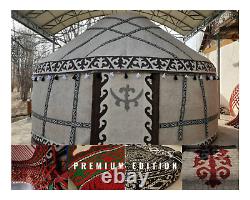
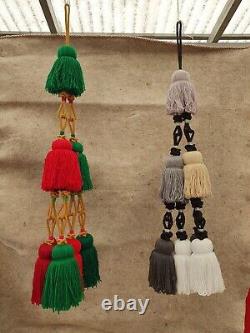

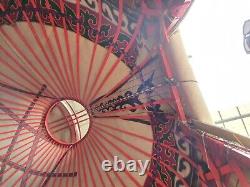
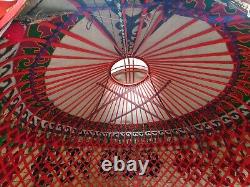


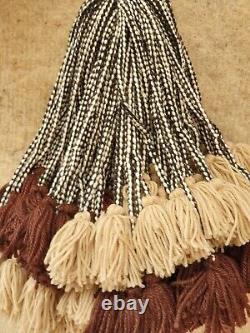


Standard Kyrgyz Yurt 16ft 5 (5m) Diameter. This is an authentic Kyrgyz Yurt, 100% handmade and decorated in Kyrgyzstan according to centuries old tradition. The diameter of the standard yurt is.
It is 11ft 10 (3.6m) high. And the floor space is 211 sq ft. This yurt will serve as your backyard dinner house, your new meditation room, a spa enclosure, guest lodge or miniature vacation home.
All our yurts include a masterfully decorated exterior felt covering and a hand crafted wooden skeleton. In addition, all our yurts feature a wide variety of included, all handmade parts and decorative elements.
THIS YURT INCLUDES THE FOLLOWING PARTS. Decorated exterior felt covering, serves as insulation layer, covers exterior walls "Tuurduk" and the yurt dome "Uzuk" (Image 1). Yurt skeleton, consist of 6 handmade wooden lattice support walls "Kerenge" (Image 2). Wooden door frame with double door "Boosogo" (Image 3).
Yurt dome, the central part of the dome in the form of a hoop "Tyundyuk" plus 85 ciling poles "Uuk" - (Image 4). Interior décor elements - traditional Kyrgyz handmade tassel ornaments for the dome and walls "Chayan Chachy" and "Kerege Chachy" - (Image 5). Interior wall, insulating reed wall panels "Chiy" covering the yurt skeleton on the inside (Image 6).
AVAILABLE AS LUXURY, PREMIUM AND STANDARD. We offer three types of interior finishes according to your taste and budget. The interior yurt wall consists of masterfully decorated reed wall panels called "Chiy" (Image 6).2 decorative felt panels called "Jabyk Bash" are mounted on the interior wall and roof (Image 7). All ribbons are hand woven and made of 100% sheep wool.
All strings are hand spun and made of 100% yak wool. Handmade tassel ornaments decorate the dome and walls. 1 decorative felt panel called "Jabyk Bash" is mounted on the interior wall (Image 7). Strings are of industrial production.The interior yurt wall consists of plain reed wall panels called "Chiy" (Image 6). Ribbons and strings are of industrial production. Decorative felt panels ("Jabyk Bash") are not included. Vinyl Covering Water Resistant - 16ft 5 (5m) diameter (Image 8). Shyrdak Felt Rug Round - 16ft 5 (5m) diameter (Image 9).
Interior Furnishing Set - Traditional Kyrgyz Kurak Pillows and Mattresses (Image 10). We propose for our customers several options of customization on interior shades and decoration elements. The interior options are natural (gray and beige) and traditional bright colors (red and green) as for the whole yurt and for certain elements of exterior and interior decorations. If you didn't find what you were looking for, we offer personalized or custom, made-to-order items. You can request a personalized custom product for an item on our listing.
We offer a full service, helping you design every element of your yurt according to your individual requirements, and we crucially offer tuition over video calls to teach you how to construct your yurt when it arrives. To learn more about the fascinating process of how create the structural pieces for your yurt, please watch this video, filmed in our workshop in Kyrgyzstan. We provide with the yurt digital paper instructions of how to assemble and disassemble a yurt as well as cleaning and storage information.
However, be aware that felt, leather and wood all natural materials need specific care for long term service. Lifetime on proper care can go for 50 years.Each yurt is assembled, inspected by our team to check all elements and bindings (and includes additional poles and bakan for assembling). Inspection video will be sent once the item is manufactured and ready for packaging. When treated well, a quality yurt made to modern standards like ours has a lifespan of up to 60 years; this is a one-off investment you will be able to enjoy for a lifetime. Yes, our yurts water-resistant because it has water-resistant vinyl covering.
Felt absorbs and evaporates moisture well, remaining dry itself. But, for our customers, we also offer a special tarpaulin (included in the price of the yurt), which helps to keep the felt cape from moisture, which in turn sheds the life of the felt for years. In summer, the protective tarp can be easily removed.
What is the lowest temperature a yurt can be used at? The yurt can be used at temperatures down to -50 degrees. One layer of felt 0.8-1cm thick is designed to -20, -30 degrees, two layers of felt -40 degrees. When ordering a two-layer felt roof, it should be understood that such a roof gives additional weight to the upper part of the yurt, and accordingly the wooden structure should also be strengthened.As a result, the total mass of the yurt can be almost doubled. It all depends on the climatic conditions where you are going to use the yurt. Yurt with a diameter of 5 meter in field conditions when using a small stove "potbelly stove" it warms up in 30-40 minutes. HOW COMFORTABLE IS IT IN TERMS OF TEMPERATURE TO USE A YURT AS A GAZEBO IN SUMMER?
Due to the properties of natural felt, the yurt is cool in summer. A yurt can be used in all seasons, not like a gabezo that can useable only in warm period. The yurt can be moved to another place more convenient for you or removed from the site for the winter. A yurt is a portable, round tent covered with skins or felt. The Turkic word "Jurt" can mean nation, homeland, or campsite. A yurt consists of a rounded wooden skeleton over which a felt cover is placed. The skeleton can be made of willow, birch, or elm in the case of very large yurts. These wooden elements form a lattice wall, called'kerege', the supports for the dome, called'uuk', and a door frame, called the'kaalga'. The'tunduk' is the keystone that holds the'uuk', the domed roof of the yurt, in place. Its design has become symbolic over the generations, and is sacred to the people of Kyrgyzstan. The circle represents both the sun, with the uuk as its rays, and the progress of the year, with the months and the four seasons represented in the design. In order to hold the yurt up and successfully shelter the people inside, the tunduk must be strong and durable, but also flexible.There is no better symbol to describe the Kyrgyz people. Central Asian nomadic civilizations, over the several thousand years of their existence, developed the yurt, a dwelling which perfectly reflects their worldview and way of life. The earliest records of the yurt are found in Chinese sources. In the Chinese "Huainanzi" records of the 2nd century BC, a yurt is defined as a "dome cabin". The oldest images of the yurt are preserved on funerary statuettes of the 6th century from northern China, and on rock carvings in the gorges of Eastern Kazakhstan.
There are two types of yurts - the Turkic and the Mongolian. They differ in the shape of their dome. The Turkic Yurt uses steam-bent wooden framing for the dome construction.
Thus, there is no need to install a support post inside the yurt. In the Mongolian Yurt, however, the dome requires the support of a post. The Turkic type of yurt is commonly found spread among the Turkic peoples of Central Asia and Siberia, who lead a nomadic or semi-nomadic way of life, while the Mongolian type, called a "Ger", is typically found among the nomads of Mongolia, Tuva, Buryatia, Kalmykia and Tibet. The yurt has been used by nomads for over three thousand years, that is why it is considered to be perfectly adapted to the nomadic way of life.
The key advantages of the yurt are its universality and its mobility. Despite a yurt's size, it can be easily taken down or set up in less than an hour. This made the yurt especially useful for both soldiers and nomads. The yurt was also the most accessible form of housing for nomads because they had easy access to all the necessary materials for construction, such as felt, leather and wood. In addition, felt offers extra protection against the harsh climate of the mountains and steppes as it keeps cool during the warm summer and warm during the cold seasons.The size, ventilation and illumination of the yurt can be easily adjusted. In hot weather, for additional ventilation, it is easy to open the sunroof simply by raising the side rope. In general yurts provide excellent air circulation because of the round shape of the walls.
Yurt installation has several steps, with most of the responsibility for setup given to the women. The first step is to set up the wooden frame and install the doorframe, which is joined to the expanding lattice wall-sections called kerege. A yurt of medium size usually consists of four kerege.The expanding lattice wall-sections are fixed by special straps made of camel and bull skin, and attached to the doorframe with woven belts (terma) decorated with ornaments. The dome of the yurt is created with special ceiling boards called uuk. Following this, the door is placed within the frame. In ancient times, the door was typically a felt mat.
The space inside the yurt forms a single room that is shared between all family members, but it is conceptually divided both horizontally and vertically by the nomads. The horizontal division is connected to the use of space and gender. The male half is called the er-zhak and is to the left hand of the entrance. This is where men keep their weapons, horse and hunting gear. The women's section is the right half of the yurt, where the kitchen utensils, foodstuffs and baby's bed are typically kept.(Standard, Premium & Luxury Finish). The wooden frame is made of willow specially grown for the manufacture of yurts. Trees are cut down in late autumn and winter, cleaned of bark and dried in the wind.
They undergo steam treatment for flexibility and strength, then they are shaped and dried. After drying, the wood is treated with oil and natural insect repellents and painted with acrylic paint.
The size and number of parts depends on the size of the future yurt. The frame of the yurt consists of the following parts. Folding lattice walls called "kerege". For kerege, the harvested tree is cut in half along its length. After acquiring the necessary shape, assembly is carried out using leather rivets. The support poles are called "uuk". For their manufacture, the tree is used in its entirety. It is shaped and a rope is threaded through its wide end and tied to the tops of the core. The round domed roof, called the "t? K", is made of a wide willow divided in half and bent into arcs. Two arcs come together to form a circle inside which half-bent sticks are cross-inserted. The yurt cover is made of dense felt of a natural gray-beige color. The felt is made from sheep's wool, cleaned only with soap, then only water is used in the manufacturing process. The edges of the coatings are edged with a thick rope to better keep the shape.The felt is cut out and sewn by hand. The yurt cover consists of the following elements. The "tuurduk", a wide felt band going around lattice walls. There are several of these, and each aligns with the next to more effectively maintain the internal air temperature.
"Uzuk", two trapezoidal felt coverings. The "tunduk jabuu", a square felt thrown over the very top of the yurt with the help of ropes. Easy to open and close providing daylight and ventilation.
The "eshik chiy", a felt roll covering the wooden door. Additional insulation cover made of felt-colored vinyl for waterproofing in rainy areas. This is provided free of charge for yurts with a diameter of more than 5 meters. The decorative and practical elements of the yurt are all hand-made.
For felt dyeing, powdered paints of Russian production are used. These elements consist of the following products.
Two woven wicker mats to go around the yurt between the trellised wall and felt covering to provide additional thermal insulation. Indoor and outdoor felt decorations with traditional patterns, macramés and handmade braid. These also contribute to thermal insulation and are made of dyed and / or naturally colored felt.
Yarn balls for the tops of the lattice walls as well as two larger ones for the dome. Decorative ribbon woven from multi-colored yarn.
The Kyrgyz Yurt store was founded in 2017. Our vision is to promote Central Asian nomadic traditions around the world. Our mission is to support artisans and to help them preserve centuries old nomadic traditions. We have been working in tourism since 2005 and realized that visitors have a great interest in our culture and tradition. With the Covid Pandemic hitting in 2020 we decided to move our business online.
We are based in Kyrgyzstan, the heart of Central Asia. All of our products are 100% handmade by local craftswomen and men from the rural areas of Kyrgyzstan. The production of yurt parts takes place in different parts of our country, and both men and women are involved in the process of manufacturing individual parts.
For example, the entire wooden structure is made by men, as it is considered hard work, and women, in particular, are busy making the felt roof of the yurt and decorating them. 100% Handmade by Kyrgyz Craftswomen and men. Available as Luxury, Premium and Standard Version. Supreme Insulation, Suitable for Cold and Hot Climate.
All Weather - Water Resistant Layer Available (Optional). Upgrades and Personalization Available (Optional). Traditional Shyrdak Floor Rugs Set Available (Optional).We produce our yurt on request as on our products photo on the listing. Production time is about 6-8 weeks depending on size and customization options of the request. For details on customization and personalization of the product for an item on our listing with the Request Custom Order button and we discuss about possible options and terms. For more information please refer to "Custom and personalized orders" section in the "Frequently asked questions".
Please contact local brokerage company, that can provide such a service and information. We recommend also to address to local municipality for regulation of yurt installation in the yard, as some Western countries requires special licensing upper certain surface. WE DON'T ACCEPT CANCELLATIONS.
In some cases, the cancelation is possible. WHAT IF MY PARCEL IS LOST OR DELAYED? We use the services of only reliable world-known carriers like DHL and Fly Cargo by now.Please ensure that the address is correct prior to placing an order. If the parcel is officially recognized as lost (due to the fault of the courier service), then ouminutes. WHERE DO WE DELIVER FROM? We are based in Kyrgyzstan which is called the heart of Central Asia. All our products are made by local handcrafters who are from the rural areas of Kyrgyzstan.
Because we handmake everything from scratch, our yurts are fully customizable to your exact specifications. Don't miss any offers!

